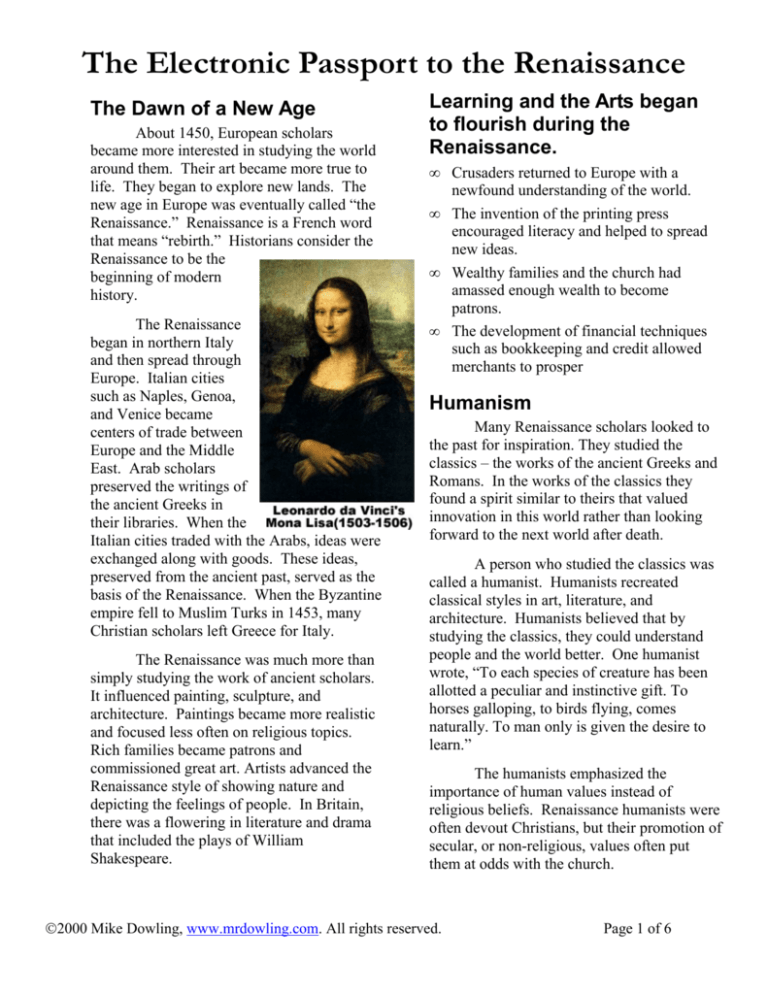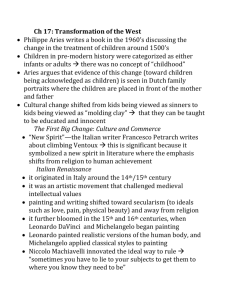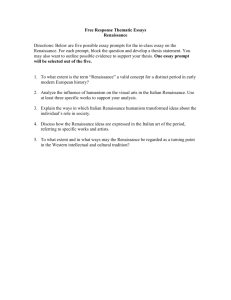
The Electronic Passport to the Renaissance
The Dawn of a New Age
About 1450, European scholars
became more interested in studying the world
around them. Their art became more true to
life. They began to explore new lands. The
new age in Europe was eventually called “the
Renaissance.” Renaissance is a French word
that means “rebirth.” Historians consider the
Renaissance to be the
beginning of modern
history.
The Renaissance
began in northern Italy
and then spread through
Europe. Italian cities
such as Naples, Genoa,
and Venice became
centers of trade between
Europe and the Middle
East. Arab scholars
preserved the writings of
the ancient Greeks in
their libraries. When the
Italian cities traded with the Arabs, ideas were
exchanged along with goods. These ideas,
preserved from the ancient past, served as the
basis of the Renaissance. When the Byzantine
empire fell to Muslim Turks in 1453, many
Christian scholars left Greece for Italy.
The Renaissance was much more than
simply studying the work of ancient scholars.
It influenced painting, sculpture, and
architecture. Paintings became more realistic
and focused less often on religious topics.
Rich families became patrons and
commissioned great art. Artists advanced the
Renaissance style of showing nature and
depicting the feelings of people. In Britain,
there was a flowering in literature and drama
that included the plays of William
Shakespeare.
Learning and the Arts began
to flourish during the
Renaissance.
• Crusaders returned to Europe with a
newfound understanding of the world.
• The invention of the printing press
encouraged literacy and helped to spread
new ideas.
• Wealthy families and the church had
amassed enough wealth to become
patrons.
• The development of financial techniques
such as bookkeeping and credit allowed
merchants to prosper
Humanism
Many Renaissance scholars looked to
the past for inspiration. They studied the
classics – the works of the ancient Greeks and
Romans. In the works of the classics they
found a spirit similar to theirs that valued
innovation in this world rather than looking
forward to the next world after death.
A person who studied the classics was
called a humanist. Humanists recreated
classical styles in art, literature, and
architecture. Humanists believed that by
studying the classics, they could understand
people and the world better. One humanist
wrote, “To each species of creature has been
allotted a peculiar and instinctive gift. To
horses galloping, to birds flying, comes
naturally. To man only is given the desire to
learn.”
The humanists emphasized the
importance of human values instead of
religious beliefs. Renaissance humanists were
often devout Christians, but their promotion of
secular, or non-religious, values often put
them at odds with the church.
2000 Mike Dowling, www.mrdowling.com. All rights reserved.
Page 1 of 6
Today we refer to the study of
literature, philosophy and art as the
humanities. The civilizations of Greece and
Rome ended long ago, but they continue to
influence us today.
Gutenberg
A good cook can take leftovers and
turn them into a delicious meal. Like a good
cook, Johann Gutenberg took what had
already been discovered, and created a small
invention that changed history. Gutenberg
created a machine that allowed him to move
small blocks of letters in such a way that
written material could be printed and massproduced. Before the printing press, few
people outside the clergy could read, but with
inexpensive books, literacy
spread through Europe.
Block printing existed
long before Gutenberg. The
Chinese had been carving
wood blocks to print books as
early as 868, but their process
had one major drawback; a
new set of woodcuts had to be
made for each book.
Producing one book was
difficult; producing a variety
of books was not practical.
Writing ink dates from about 2500 BC
in Egypt and China. They took the soot from
fires and mixed it with sap. Later civilizations
used plant material for ink, particularly the
dark blue indigo plant. Gutenberg used an oilbased printing ink that would last longer than
other inks used in his time.
Gutenberg published the first mass-produced
book: a 1,282 page Bible. To this day, more
copies of the Bible have been printed than any
other book.
Copies of Gutenberg’s invention
spread throughout Europe, but Gutenberg did
not get rich from his invention. Patents did
not yet exist, so anybody could build a
printing press without compensating
Gutenberg for his inspiration. Some religious
and government officials denounced the
invention of printing because they feared that
it would spread bad ideas. But they were a
minority. By 1500 there were 1,700 printing
presses in Europe. The presses had already
produced about 20 million volumes of 40,000
different books.
City-states in Italy
During the Middle
Ages, much of Italy was
controlled by the Holy
Roman Empire. As the
emperors and popes fought
for control, both were
weakened. Several Italian
cities formed states that
were independent of both
the empire and the church.
Venice and Florence were
two centers of power and
wealth that became the cradle of the
Renaissance.
Venice was founded in the fifth
century by people fleeing from Attila the Hun.
They settled on a group of islands on the
northeastern edge of the Italian peninsula.
Shipbuilding was the primary industry in
Venice. During the Crusades, Venetian ships
provided transportation to the Holy Land. By
the 13th century, Venice was the most
prosperous city in Europe. The city became
rich by collecting taxes on all merchandise
brought into its harbor. Venice built huge
warships that protected the valuable cargo of
its merchant ships from pirate raids. With the
We don’t know much about Gutenberg
because he was not famous during his
lifetime. We know that he was born in
Germany about 1400, and he worked as a
goldsmith. In 1448, he developed engraved
signatures for each number, letter, and
punctuation mark. Gutenberg then built the
molds to hold the signatures in place, and
borrowed money to purchase a press.
2000 Mike Dowling, www.mrdowling.com. All rights reserved.
Page 2 of 6
vast wealth from trade, many of the leading
families of Venice vied with one another to
build the finest palaces or support the work of
the greatest artists.
Florence, the “city of flowers,” was
located in the hill country of north-central
Italy. It prospered because of the wool
industry. Sheep were raised in the rock hill
country of central Italy, and Florence was a
center of wool processing. During most of the
Renaissance, wealthy merchants dominated
Florence.
The merchants
competed with one
another by building
grand palaces for
themselves. The
merchants were patrons
of the arts. Patron comes
from the Latin word for
father. They hired artists
to fill their homes with
beautiful paintings and
sculptures. Patrons
bought rare books and
paid scholars to teach
their children. The
money and
encouragement of
patrons together with
that of the church, made
the masterpieces of
Renaissance art possible.
The Medicis
In the 15th century, the leading families
of Florence decided they needed a strong
person in charge to lead them against the
growing threat of rival cities. They chose
Cosimo de Medici, a wealthy banker, to take
control of the government. Cosimo
maintained the appearance of republican
government, but he appointed his relatives and
people he could control to important positions.
When Cosimo died in 1464, his son and
grandson continued his policies. The Medici
maintained control by exiling people who
disagreed with them and encouraging other
Italian cities to form alliances with Florence.
The best known of the Medicis was
Cosimo’s grandson, Lorenzo, who was known
as “Lorenzo the Magnificent.” Lorenzo was
not only a shrewd banker and clever
politician; he was also a scholar and a poet.
Under Lorenzo’s leadership, Florence became
one of the most beautiful and prosperous cities
in Italy, as well as a center of the Renaissance.
Social levels
The people of
Renaissance Florence, like most
city–states of the era, were
composed of four social classes.
The nobles owned much of the
land, and lived on large estates
outside the city walls. They
behaved according to the rules
of chivalry and distained the
merchants.
The merchants were the
newly rich, who gained wealth
in industries like wool
processing, boat making and
banking. The merchants sought
to protect their wealth by
controlling the government and
marrying into noble families.
They became patrons of great
artists in order to gain public
favor. The middle class of
Florence was composed of
shopkeepers and professionals
At the lowest level were the workers,
who did not have job protection and were very
dependent on their employers. Workers who
violated rules could have their wages withheld
or could be discharged from their jobs. As
difficult as their lives were, however, these
urban workers were better off than the
peasants who lived in rural areas.
2000 Mike Dowling, www.mrdowling.com. All rights reserved.
Page 3 of 6
Renaissance Art
The Renaissance
patrons wanted art that
showed joy in human
beauty and life’s pleasures.
Renaissance art is more
lifelike than in the art of the
Middle Ages. Renaissance
artists studied perspective,
or the differences in the way
things look when they are close to something
or far away. The artists painted in a way that
showed these differences. As a result, their
paintings seem to have depth.
An artist from Florence named Giotto
was one of the first to paint in this new style.
Giotto lived more than a century before the
beginning of the Renaissance, but his
paintings show real emotion. The bodies look
solid, and the background of his paintings
shows perspective. The art produced during
the Renaissance would build upon Giotto’s
style.
Leonardo da Vinci was born in 1452 in
the village of Vinci. His name means
Leonardo of Vinci. Leonardo began his career
working for a master painter in Florence. By
1478, Leonardo left his master and set up his
own workshop. People have been trying to
guess the secret behind the smile of his Mona
Lisa ever since he painted it around 1505. His
Last Supper shows clearly the different
feelings of Jesus and his followers.
“Renaissance Man,” skilled in many fields.
He was a scientist and an inventor as well as
an artist. He made notes and drawings of
everything he saw. Leonardo invented clever
machines, and even designed imitation wings
that he hoped would let a person fly like a
bird.
Michelangelo Buonarroti of Florence
was one of the greatest artists of all time.
Like Leonardo, Michelangelo was a
“Renaissance Man” of many talents. He was
a sculptor, a painter, and an architect. When
Michelangelo carved a statue of Moses, he
included veins and muscles in the arms and
legs.
Michelangelo was a devout Christian,
and the church was his greatest patron. He
designed the dome of St. Peter’s church in
Rome. Nearby, Michelangelo’s paintings
cover the ceiling of the Sistine Chapel, the
building where new popes have been selected
for more than five hundred years.
Michelangelo’s painting illustrates the Book
of Genesis, with scenes that span from the
Creation to the Flood. The project was very
Leonardo’s fame grew—but not just
difficult. Working alone, Michelangelo had to
for his painting. Leonardo was truly a
lie on his back atop high scaffolding while
he painted the vast ceiling.
The ceiling of the Sistine Chapel is one of the
world’s most famous paintings, but not everyone
was happy with Michelangelo’s work. Cardinal
Biagio de Cesena noted that the crowd of more
than 300 human figures would be more
appropriate in a wine shop than in a papal chapel.
Michelangelo responded to this criticism by
adding a portrait of Biagio among the figures of
the damned in the scene of the Last Judgment.
The Renaissance Spreads
The rebirth of the Italian cities
attracted visitors from all over western
Europe. Merchants and bankers hoped to
make their fortunes in the Italian citystates. Artists and students sought
knowledge and fame. When these
2000 Mike Dowling, www.mrdowling.com. All rights reserved.
Page 4 of 6
to understand how to use the methods of the
beast and the man . . .
A prince . . . ought to choose the fox
and the lion; because the lion cannot defend
himself against traps and the fox cannot
defend himself against wolves. Therefore, it
is necessary to be a fox to discover the traps
and a lion to terrify the wolves. Those who
rely simply on the lion do not understand
this.”
travelers returned home, they brought
Renaissance ideas with them. In time, the
ideas of the Renaissance influenced people far
from the Italian peninsula.
William Shakespeare is the best-known
writer of the Renaissance. His plays mixed
humor with drama, and showed the strengths
and weaknesses of people. Audiences flocked
to see his presentations of Roman emperors,
British kings and queens, and Italian
teenagers.
Pieter Bruegel was a Dutch painter
who wanted to show people as they really
were. Breugal studied Italian art, but he
developed his own style. Many of his
paintings show peasants working, dancing,
and eating.
Machiavelli
Niccolo Machiavelli was one of the
most influential writers of the Renaissance.
He believed Italy could not be united unless
its leader was ruthless. In 1513, he wrote The
Prince, where he advised rulers to be kind
only of it suited their purposes. Otherwise, he
warned, it is better to be feared than loved.
“You must know there are two methods
of fighting, the one by law, the other by force;
the first method is of men, the second of
beasts; but because the first is frequently not
sufficient, one must have recourse to the
second. Therefore it is necessary for a prince
-- Niccolo Machiavelli, The Prince
(1513)
Europeans Explore the World
In the second half of the 15th century,
European sailors began to plan voyages that
would take them beyond the limits of the
world they knew. The new interest in the
world came in part from the Renaissance, but
the main reason was to set up new trading
links with spice-producing lands in Asia.
Spices were an essential part of
everyday life for the Europeans. Refrigeration
had not yet been invented, so the only way to
preserve meat was to salt it. Adding spices
helped to hide the salty taste. The spices also
concealed the taste of meat that had gone bad.
The Turks defeated the Byzantine
Empire in 1453, cutting the land link between
Europe and Asia. If spices were to reach
Europe, a sea route to Asia had to be found.
Prince Henry the Navigator of Portugal set up
a school for sailors and encouraged the
exploration of the African coast. In 1486,
Bartholomeu Dias and his crew became the
first Portuguese sailors to reach the southern
tip of Africa, but he turned back because his
crew was unwilling to travel any further. Ten
years later, Dias helped another Portuguese
sailor, Vasco da Gama, plan a voyage around
Africa to India.
Christopher Columbus hoped to reach
India by sailing west. When the Portuguese
king would not sponsor his voyage, he asked
2000 Mike Dowling, www.mrdowling.com. All rights reserved.
Page 5 of 6
Ferdinand and Isabella of Spain. After six
years, they agreed. When Columbus reached
a group of islands across the Atlantic Ocean in
1492, he was certain he had reached his goal.
Columbus called the native people Indians.
This is why the Caribbean islands are known
as the West Indies. Columbus made three
more voyages to the Caribbean, but he never
realized his mistake.
Magellan
Aristotle first theorized that
the earth was round. Columbus died
believing he proved Aristotle correct,
but the real confirmation came in the
expedition of Ferdinand Magellan,
the captain of the first ship to sail
completely around the world.
Enrique was the first person to have traveled
completely around the world.
Magellan had survived eighteen
months at sea, but he was killed in battle in
the Philippines. A local warrior persuaded
Magellan to defeat his rival in battle. Most of
Magellan’s men considered the battle both
pointless and dangerous, so they refused to
participate. Magellan was hit with a
poison arrow in the battle and died.
One of Magellan’s five ships
did make it back to Spain, only twelve
days less than three years after their
journey started. Only one ship and
eighteen sailors remained of the 265
men accompanied Magellan.
Magellan was a Portuguese sailor who
explored Asia. While he was in Asia,
Magellan picked up an Asian boy he called
Enrique, who he brought back to Portugal.
Magellan asked the King of Portugal to
finance an expedition around the world.
When the king rejected him, Magellan
disowned his allegiance to Portugal and
offered his services to Spain.
Magellan left Spain in 1519 with five
ships. It took more than fourteen months to
find the southern opening to the Pacific
Ocean. He found it in the frigid, stormy
waters now known as the Strait of Magellan.
What Magellan did not count on was the
immensity of the Pacific, a body of water
larger than all of the land on earth. Magellan
expected Asia to be a few hundred miles past
beyond the coast of South America. Instead,
the expedition traveled 12,600 miles before
reaching land.
The starving sailors arrived the island
of Guam after more than six months at sea,
and then moved on to the Philippines. While
in the Philippines, Magellan discovered that
his servant, Enrique, could understand the
native language. Magellan realized that
2000 Mike Dowling, www.mrdowling.com. All rights reserved.
Page 6 of 6









